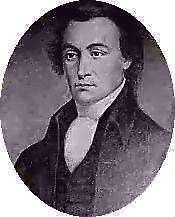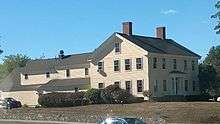Matthew Thornton
Matthew Thornton (1714 – June 24, 1803) was an Irish-born signer of the United States Declaration of Independence as a representative of New Hampshire.
Matthew Thornton | |
|---|---|
 | |
| Born | 1714 |
| Died | June 24, 1803 (aged 88–89) |
| Resting place | Thornton Cemetery, Merrimack, New Hampshire |
| Known for | Signer of the United States Declaration of Independence |
| Signature | |

Background and early life
Thornton was born in Ireland in 1714 to James and Elizabeth (née Jenkins) Thornton, who were Scots-Irish.[1] At the time of the Siege of Derry in 1689, James Thornton lived on a farm within a mile of Londonderry and this is where Matthew was probably born.[2]
In 1716, Thornton's family immigrated to North America when he was three years old, settling first in Wiscasset, Maine.[3][4] On July 11, 1722, the community was attacked by Native Americans.[4] James and Elizabeth Thornton fled from their burning home with Matthew, moving shortly thereafter to Worcester, Massachusetts.[5] Thornton completed studies in medicine at Leicester.[4] He became a physician and established a medical practice in Londonderry, New Hampshire.[4] He was appointed as a surgeon for the New Hampshire Militia troops in an expedition against Fortress Louisbourg in 1745.[6] He served in the New Hampshire Provincial Assembly from 1758-62, had royal commissions as justice of the peace, and served as colonel in the militia from 1775 until his resignation in 1779.[7]
In 1760 Thornton married Hannah Jack, and the couple had five children.[4] Thornton became a Londonderry selectman, a representative to and President of the Provincial Assembly, and a member of the Committee of Safety, drafting New Hampshire's plan of government after dissolution of the royal government, which was the first state constitution adopted after the start of hostilities with England.
Continental Congress
He served as the President of the New Hampshire Provincial Congress in 1775, and from January to September 1776, as Speaker of the New Hampshire House of Representatives.[8] He was elected to the Continental Congress after the debates on independence had occurred, but as he did not arrive in Philadelphia until November 1776, he was granted permission to actually sign the Declaration of Independence four months after the formal signing in July.[9]
Later life
He became a political essayist. He retired from his medical practice and in 1780 moved to Merrimack, New Hampshire, where he farmed and operated Thornton's ferry with his family. Although he did not attend law school,[9] he served as a judge on the New Hampshire Superior Court from 1776-82.[8]
In 1783, Thornton represented the towns of Merrimack and Bedford in the New Hampshire House of Representatives, and then Hillsborough County in the New Hampshire Senate from 1784-87, while simultaneously serving as a State Councillor from 1785-86, and as a state representative again for Merrimack in 1786.[10] His wife Hannah (Jack) Thornton died in 1786.
Thornton died in Newburyport, Massachusetts, while visiting his daughter. He was 90 years old.[9] Matthew Thornton is buried in Thornton Cemetery in Merrimack, and his cenotaph reads "The Honest Man."[11]
Legacy and family
The town of Thornton, New Hampshire, is named in his honor, as is a Londonderry elementary school, and Thorntons Ferry School in Merrimack. Thornton's residence in Derry, which was part of Londonderry at the time, is listed on the National Register of Historic Places. He is featured on a New Hampshire historical marker (number 79) along U.S. Route 3 in Merrimack.[12]
Thornton was the uncle of Capt. Matthew Thornton, a suspected Loyalist who was charged with treason related to actions just before the Battle of Bennington in 1777. Ebenezer Webster, father of Daniel Webster, was enlisted to investigate the allegation. At his trial Capt. Thornton pleaded not guilty. Evidence was presented both for and against and the jury found him not guilty, whereupon he was discharged.[13]
References
- "The Ulster-Scots and New England: Scotch-Irish foundations in the New World" (PDF). Ulster-Scots Agency. p. 4. Archived from the original (PDF) on February 7, 2014. Retrieved July 20, 2019.
- Adams, Charles Thornton (1903). Matthew Thornton of New Hampshire: A Patriot of the American Revolution. Philadelphia: Dando Printing and Publishing Company. p. 13.
- "Signers of the Declaration of Independence: Matthew Thornton". Ushistory.org. Retrieved 26 June 2019.
- Reynolds, Alistair, "Matthew Thornton" Archived 2013-10-23 at the Wayback Machine Maine Ulsterscots Project, retrieved October 8, 2014
- Ferris, Robert, and Morris, Richard, Signers of the Declaration of Independence, Interpretive Publications Inc., Flagstaff, Arizona, 1982; ISBN 0-936478-07-1, p. 139
- "Glimpses of the Past", St. Croix Courier, St. Stephen, New Brunswick, April 26, 1894, retrieved 12-03-11
- Adams, Charles Thornton (1903). Matthew Thornton of New Hampshire: A Patriot of the American Revolution. Philadelphia: Dando Printing and Publishing Company. p. 21.
- Adams, Charles Thornton (1903). Matthew Thornton of New Hampshire: A Patriot of the American Revolution. Philadelphia: Dando Printing and Publishing Company. pp. 22–33.
- Ferris and Morris, p. 140
- Adams, Charles Thornton (1903). Matthew Thornton of New Hampshire: A Patriot of the American Revolution. Philadelphia: Dando Printing and Publishing Company. p. 57.
- Matthew Thornton at Find a Grave
- "List of Markers by Marker Number" (PDF). nh.gov. New Hampshire Division of Historical Resources. November 2, 2018. Retrieved July 5, 2019.
- Adams, Charles Thornton (1905). The family of James Thornton, father of Hon. Matthew Thornton. Boston Public Library. New York : pp. 23–24 [s.n.]
Further reading
External links
| Wikimedia Commons has media related to Matthew Thornton. |
- Webb, Alfred (1878). . A Compendium of Irish Biography. Dublin: M. H. Gill & son – via Wikisource.
- United States Congress. "Matthew Thornton (id: T000242)". Biographical Directory of the United States Congress.
